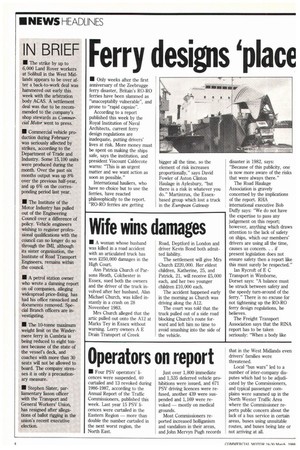Ferry designs 'place lives at risk'
Page 6

Page 7

If you've noticed an error in this article please click here to report it so we can fix it.
• Only weeks after the first anniversary of the Zeebrugge ferry disaster, Britain's RO-RO ferries have been slammed as "tmacceptablly vulnerable", and prone to "rapid capsize".
According to a report published this week by the Royal Institution of Naval Architects, current ferry design regulations are inadequate, putting drivers' lives at risk. More money must be spent on making the ships safe, says the institution, and president Viscount Caidecote warns: "This is an urgent matter and we want action as soon as possible."
International hauliers, who have no choice but to use the ferries, have reacted philosophically to the report. "RO-RO ferries are getting bigger all the time, so the element of risk increases proportionally," says David Fowler of Aston Clinton Haulage in Aylesbury, "but there is a risk in whatever you do." Martintrux, the Essexbased group which lost a truck in the European Gateway disaster in 1982, says: "Because of this publicity, one is now more aware of the risks that were always there."
The Road Haulage Association is gravely concerned by the implications of the report. RHA international executive Bob Duffy says: "We do not have the expertise to pass any judgement on this report; however, anything which draws attention to the lack of safety on ships, which our members' drivers are using all the time, causes us concern. . . if present legislation does not ensure safety then a report like this must surely be respected."
Ian Rycroft of E C Transport in Wimborne, Dorset says: "A balance must be struck between safety and the speedy turn-around of the ferry." There is no excuse for not tightening up the RO-RO ferry design regulations, he believes.
The Freight Transport Association says that the RINA report has to be taken seriously: "When a body like the Royal Institution of Naval Architects comes out so strongly, the Government must react. Our members just assume that as much as possible is being done to make ferries safer."
The RINA report points out that technical solutions to the problem of rapid capsize following flooding are available — but the means of their enforcement are not.
One fundemental problem is the vast surface area of car decks. If two centimetres of water were to cover a flat car deck, the slighest roll in the ship would cause tonnes of water to shift to one side. According to Commercial Motor's sister publication Motor Ship, one safety measure which might be considered is the installation of longitudinal bulkheads running the full length of open car decks. "This would greatly improve the inherent safety of full-width car deck RO-RO ships," it says. The Herald of Free Enterprise did not have such a bulkhead, nor did the Vinca Gorthon RORO, which went down in the North Sea last month. The institution's statement outlines further problems in existing designs. These include: high permeability in some compartments which can admit large volumes of water; the dangers of fire on the vehicle decks and and in accomodation areas immediately above them; and the possibility that it might not be possible to evacuate thousands of passengers safely in a very short time.
The General Council of British Shipping, which represents most British ship owners, finds it a "little curious" that the institution should release such a statement before the Department of Transport has completed its own research.
The GCBS notes that "standards of safe construction of vessels are determined by the 131 nations who are members of the United Nations International Maritime Organisation (IMO). "All governments, including that of the UK, come to their conclusions on these matters with the aid of professional advice." Present designs conform with the rest of the world, it says.
















































































































